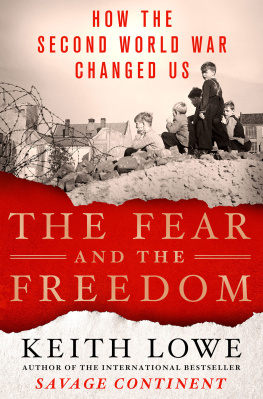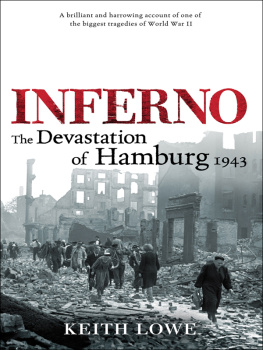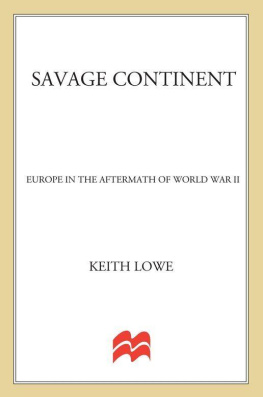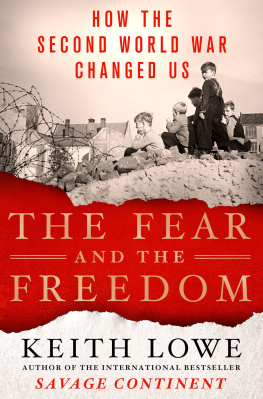Keith Lowe - Inferno
Here you can read online Keith Lowe - Inferno full text of the book (entire story) in english for free. Download pdf and epub, get meaning, cover and reviews about this ebook. publisher: Scribner, genre: Science. Description of the work, (preface) as well as reviews are available. Best literature library LitArk.com created for fans of good reading and offers a wide selection of genres:
Romance novel
Science fiction
Adventure
Detective
Science
History
Home and family
Prose
Art
Politics
Computer
Non-fiction
Religion
Business
Children
Humor
Choose a favorite category and find really read worthwhile books. Enjoy immersion in the world of imagination, feel the emotions of the characters or learn something new for yourself, make an fascinating discovery.

- Book:Inferno
- Author:
- Publisher:Scribner
- Genre:
- Rating:4 / 5
- Favourites:Add to favourites
- Your mark:
- 80
- 1
- 2
- 3
- 4
- 5
Inferno: summary, description and annotation
We offer to read an annotation, description, summary or preface (depends on what the author of the book "Inferno" wrote himself). If you haven't found the necessary information about the book — write in the comments, we will try to find it.
Inferno — read online for free the complete book (whole text) full work
Below is the text of the book, divided by pages. System saving the place of the last page read, allows you to conveniently read the book "Inferno" online for free, without having to search again every time where you left off. Put a bookmark, and you can go to the page where you finished reading at any time.
Font size:
Interval:
Bookmark:
Keith Lowe was born in London, England, in 1970. He graduated with a masters in English Literature from Manchester University and now works as an editor for a British history publisher. His first novel, Tunnel Vision, was shortlisted for the 2002 Authors Club First Novel Award. This is his first work of nonfiction. He lives in London with his wife and son.
I am extremely grateful to the staff at the many institutions that have become essential to the creation of a book like this. The most important of these were, in no particular order, the Air Force University in Alabama, the U.S. National Archives in Washington, the Reichelt Oral History program at Florida State University, Rutgers Oral History Archive of World War II, the British Library, the Imperial War Museum in London, the Royal Air Force Museum, the U.K. National Archives, the Museum fr Hamburgische Geschichte, and the Forschungsstelle fr Zeitgeschichte in Hamburg. I have been consistently surprised at the knowledge and helpfulness of the staff in such institutions on both sides of the Atlantic, and am truly grateful for their existence.
Special mention must be made of the various Geschichtswerksttten and Stadtteilarchive in Hamburg, most of which are run with extremely limited funds, and rely on the unbounded enthusiasm of the people who run them. I am particularly indebted to Grunhild Ohl-Hinz of the St. Pauli-Archiv and Sielke Salomon of Galerie Morgenland Geschichtswerkstatt Eimsbttel, both for giving me access to unpublished material and for introducing me to survivors of the firestorm. Tim Bottoms at the Mighty Eighth Museum in Georgia and Robin Sellers at Florida State University should also be mentioned for assistance above and beyond the call of duty. Also Klaus Gille of the Carl Hagenbeck Archiv, who kindly provided me with information about the destruction of Hamburgs zoo.
Where possible, I have tried to restrict myself to quoting contemporary diaries and letters in this book, since the details they give are more likely to be accurate. However, stories told face to face have an immediacy that can sometimes be lacking in written accounts. I would therefore like to express my deep gratitude to the men and women who have both shared their diaries and consented to be interviewed for this book, especially: Leonard Bradfield, Wanda Chantler, Leonard Cooper, Walter Davis, Lishman Easby, Ted Edwards, Doug Fry, Liselotte Gerke, Ted Groom, Colin Harrison, Kenneth Hills, Norman Jones, Beege Margot, Wallace McIntosh, Bill McCrea, Gordon Moulton-Barrett, Ted Neville, F. H. Quick, James Sullivan, Denys Teare, Trevor Timperley, and Louis P. Wooldridge.
There are several individuals whom I must thank for their help with research. I could not have covered the German side of the story in nearly so much detail without the help of Malte Thieen and Mirko Hohmann. David Isby got me started on the American research, and Paul Wolf was an enormous help at the U.S. National Archives. Harry D. Gobrecht was very helpful with information relating to the USAAFs 303rd BG. Although I did not have time to follow up all the leads they gave me, Penny Ash and Keith Hill were generous with their own lists of contacts. The irrepressible Peter Hart of the Imperial War Museum not only helped with oral history sources but kept me smiling as well. Thanks must also go to H. E. Batchelder of the RAF Ex-Prisoner of War Association, Nigel Parker of Bomber Command News and Frank Haslam of the British & Commonwealth Air Unit Register, and Oliver Clutton-Brock. My wife, Liza, gave me excellent advice on ways to improve the manuscript, as did Ion Trewin and Ian Drury. I must also thank Sonia Stammwitz, Jenny Piening, and Sylvia Goulding for their help with translating some of the denser German documents.
As always, I am very grateful also to my agents: Simon Trewin and Claire Scott at PFD; Nicki Kennedy, Mary Esdaile, and all at ILA; and Dan Mandel at Sanford J. Greenburger Associates.
I must thank Methuen for permission to quote from Bertolt Brechts To Those Born Later in Chapter 5; and Farrar, Straus & Giroux for permission to quote from Primo Levis Give Us in Chapter 6.
Lastly I must thank all those at my publishers who have made this book possible. After working for several years in the publishing industry myself, I know what an enormous amount of effort goes into the creation, publicizing, and marketing of a book, and I am grateful to everyone at Simon & Schuster for all their hard work. In particular I must thank my editors Lisa Drew, Roz Lippel, and Sam Martin for all their patience, their excellent advice, and their constant enthusiasm for this book throughout the publishing process.
Y EAR | D ATE | E VENTS AND D ESCRIPTION |
Charlemagne begins building a fortress called Hamma-burg at the point where Alster meets the Elbe. | ||
Franconian emperor Ludwig the Pious sends Benedictine monk Ansgar to pitch tents on the Elbe and appoints him bishop. | ||
Viking marauders reduce Hammaburg to rubble. | ||
9th-13th | C | Reign of Schauenburg counts allows city to flourish and expand to south of the Elbe. |
1186-87 | Adolf III von Schauenburg parcels out wasteland to west of old town, and a mercantile settlement and harbor are constructed. This becomes Neustadt. | |
1189 | May 7 | According to tradition, Emperor Frederick Barbarossa grants Adolf III the right to duty-free trade all along the Lower Elbe to the point where it flows into the North Sea. |
1190 | Inhabitants revolt and try to free themselves from aristocratic rulers. | |
1201 | Hamburg is invaded by Danes. | |
1227 | Danes expelled by Adolf IIIs son, Count Adolf IV. | |
1235 | Alster is dammed. | |
1250 | Population 5,000. | |
1265 | Barbarossas Charter is formally drawn up. | |
13th C | Hamburg joins Hanseatic League. | |
1400 | Population 7,500. | |
early 1400s | Klaus Stoertebeker and Godeke Michels, Hamburgs equivalent of Robin Hood, wage buccaneer war against Hanseatic fleet. | |
1510 | Emperor Maximillian I declares Hamburg an Imperial Cityan important step in gaining emancipation from Danes. | |
1558 | Founding of Hamburg Stock Exchange. Population around 20,000. | |
16th C | Lutheran reformation in city carried through by Johannes Bugenhagen. Influx of Protestants to city to avoid persecution elsewhere. | |
early 17th C | Influx of Sephardic Jews from Portugal and Spain to avoid persecution. | |
1619 | Founding of Bank of Hamburg. | |
1800 | Population 130,000. | |
1806 | Napoleon invades Hamburg. | |
1814 | Napoleons troops repelled. | |
1815 | Congress of Vienna guarantees freedom of the city. | |
1842 | The Great Fire. | |
1847 | Founding of HAPAG (Hamburg-Amerikanische-Packetfahrt-Actien-Gesellschaft)to become the biggest ship business in Germany. | |
1867 | Hamburg joins North German League. | |
1871 |
Font size:
Interval:
Bookmark:
Similar books «Inferno»
Look at similar books to Inferno. We have selected literature similar in name and meaning in the hope of providing readers with more options to find new, interesting, not yet read works.
Discussion, reviews of the book Inferno and just readers' own opinions. Leave your comments, write what you think about the work, its meaning or the main characters. Specify what exactly you liked and what you didn't like, and why you think so.










